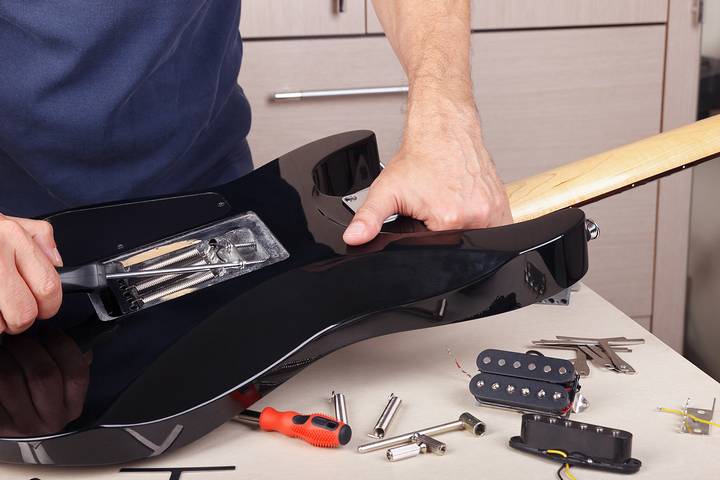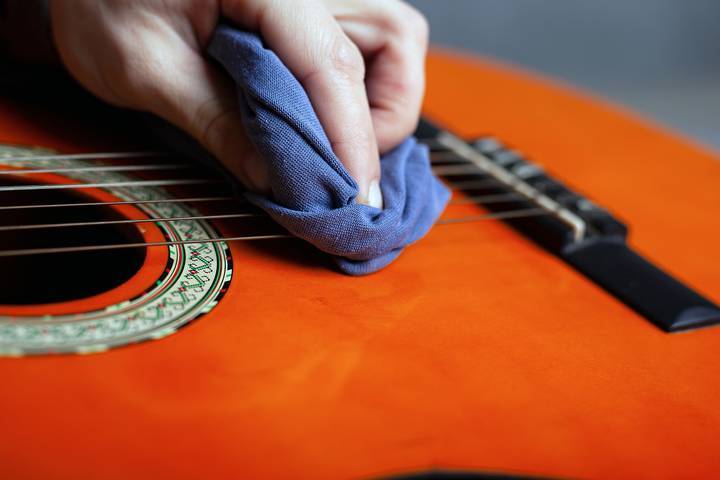5 Different Benefits of a Nitro Finish on a Guitar
Your guitar is more than an instrument to make music with. It is also a statement piece that you choose because of its look and feel. New and used instruments are made to last, but regular practicing and gigging can take a toll on the finish, leaving you with a weathered axe that shows its wear.
What type of finish is on your guitar? Different methods of colouring and sealing are designed to protect while retaining the sound and look people love. Among the methods is nitrocellulose, a classic treatment that has stood the test of time.
Not sure if it’s for you? Let’s see if we can convince you.
These are the benefits of a nitro finish on a guitar.
Benefit #1: Simple Repair and Touch-up

Once damaged or worn, some finishes need to be sanded down to start from a clean slate. With nitrocellulose, it is an easier process.
Applying a clean coat across a nitro guitar allows for an even surface because of the thinner lacquer used to finish the nitro. Repair and touch-ups are also a breeze as they dissolve into already-cured lacquer. Because of the history of using a nitro finish, repair has become a tried and true process.
It involves applying a small amount of nitrocellulose lacquer to the scratch dent or worn area and allowing it to dry. Then, you can buff and polish it until it seamlessly blends with its surroundings.
Benefit #2: Easier to Add Dye and Tinting

If you want to change your classical guitar’s colour design, nitro is the perfect surface. Nitro lacquer is very porous and is usually applied very thinly, making it ideal for dyeing and tinting over top.
Once applied to the surface, the dye penetrates the surface to bond with the wood underneath. The result is a richer colouring and better blending of tints for smoother gradients and transitions between them, which is hard to duplicate with other finishes.
Benefit #3: Better Quality Sound

There is much debate about whether the type of finish on a guitar affects the sound. Purists know how the lacquer’s thickness changes the instrument’s tone and resonance because the sound is created from the natural vibrations of the wood expanding and contracting.
Nitrocellulose is applied thinly and is breathable and flexible, allowing the energy transfer of the strings to vibrate sound on the top, sides, and back of the guitar body. The result is a broader, richer tone that can be detected in recorded and live performances.
Benefit #4: Gentle Aging

They say the older things are, the longer they last, and this holds with a nitro finish, even as it shows its age. Over time, nitro can turn yellow and wear, and as nicks and scratches show up on the surface, it only enhances the classic look of the guitar.
A textured, vintage appearance on your instrument tells a story of hard playing and perfecting your craft, one gig at a time. This gentle aging is a visual timeline for the player and his axe.
Benefit #5: Overall Look

Newer lacquering products are often made for durability, and while they can produce a decent finish, they don’t hold a candle to the classics.
Nitro was perfected to create amazing, deep lustre and sheen that is hard to reproduce. It is a thin, breathable layer that still allows the wood’s natural texture and beauty to shine while enabling the wood grain to be more pronounced.
This organic aesthetic is what musicians and collectors are looking for, so if you are refinishing an old guitar or shopping for a new-to-you one, opt for a nitro finish.
These are the benefits of a nitro finish on a guitar. The rest is up to you to decide if you want a modern guitar with a durable finish or an old classic that shows its miles but looks and sounds amazing!
Where Do You Find Nitro Finish?

Nitrocellulose lacquer became the go-to finishing choice for popular manufacturers like Gibson and Fender in the 1950s and 60s, but the lacquer itself was invented in the early 20s.
Car and furniture manufacturers adopted nitro lacquer, and instruments soon followed suit. The benefit is that as each subsequent layer was applied, the thinners melted into the previous coat and created a perfect bond.
You will see this amazing finish on most classic guitars and on those that have been refinished to recapture the essence and honour the classic instruments of the old.
Even with new applications, many high-end guitars are damaged deliberately to “relic” them to meet the demand for vintage, older-looking instruments. Fortunately, nitro lacquer is easy to scuff and marr and easier to refinish when necessary.

